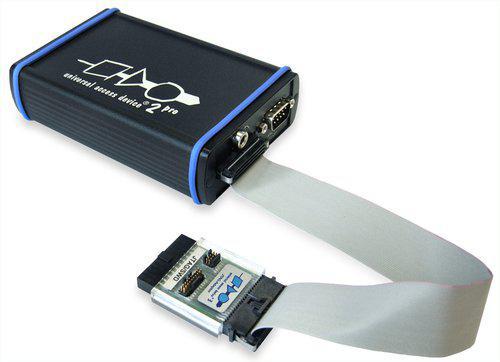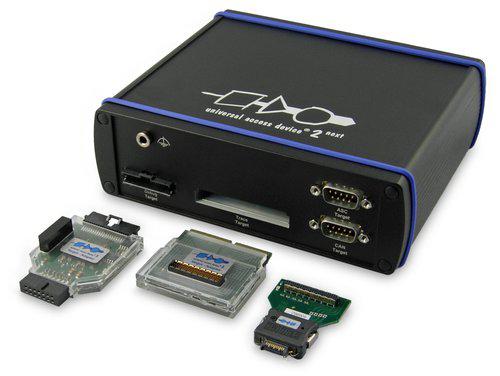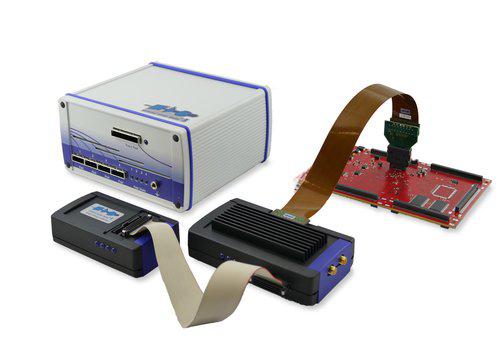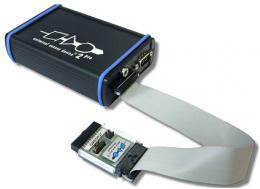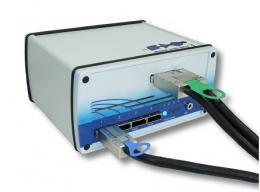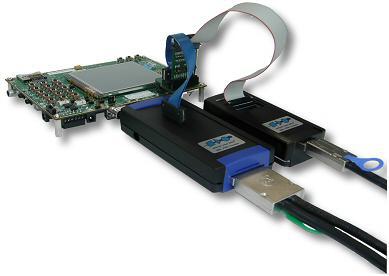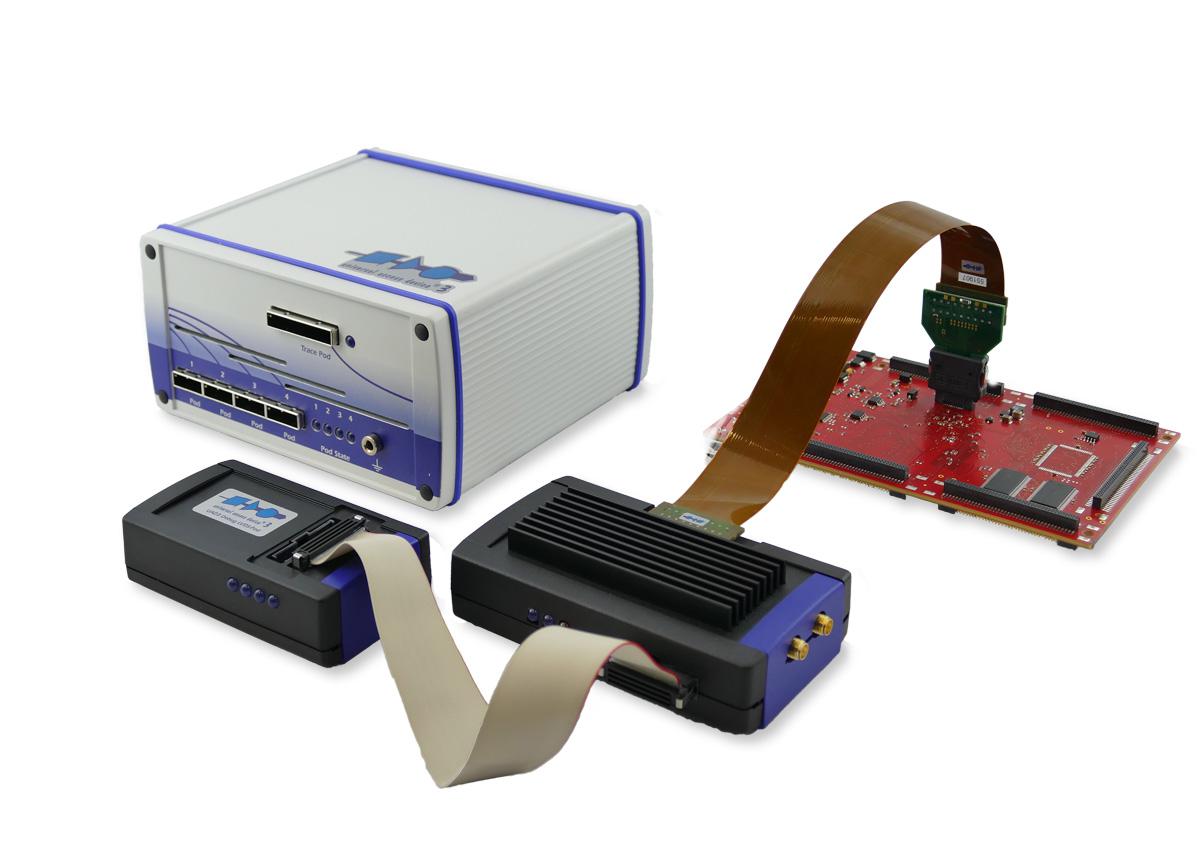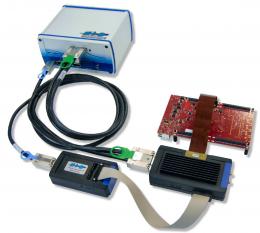Universal Access Devices UAD for Microcontroller debugging via JTAG, cJTAG, DAP, SWD, OnCE, LPD, DXCPL, CAN, ASC, Trace
With a powerful 32-bit Communication Unit based Universal Access Device, PLS presents an extremely rapid and flexible communication tool to access a multitude of popular 16-/32- and 64-bit microcontrollers.
UAD2pro ... The Universal Access Device 2pro is the new smart member of the UDE® target Access Device family ... read more.
UAD2next ... The Universal Access Device2next is the powerful successor of UAD2+ and is the new all-in-one device in PLS’s UDE® target access device family ... read more.
UAD3+ ... The Universal Access Device3+, a further development of the already established UAD2 family, was particularly optimized for use in multicore and multi-target systems with high clock frequencies ... read more.
UAD2pro
The Universal Access Device 2pro is the new smart member of the UDE® target Access Device family. It replaces the approved UAD2 and offers new enhancements in the well-known form style. It establishes a bridge to the more powerful UAD3+ using the same target adapter solution.
UAD2pro offers fastest target access via JTAG, cJTAG, DAP, DAP over CAN Physical Layer (DXCPL), SPD (Single Pin DAP) via CAN, SWD, ASC and CAN with build-in ESD protection. Accessing your AURIX, TriCore, PowerArchitecture, S32V234, Cortex, C16x, ST10, XC2000, XE166, XMC4500, Arm7, Arm9, Arm11, SuperH SH-2A derivatives is now easier than ever. The unique combination of JTAG and CAN bus, measurements of a mere 8.5 x 13 x 3.5 cm³ (W x D x H), and a robust aluminum housing, predestine the UAD2pro for mobile use in the field.
For debugging microcontroller boards with high-voltage components, as is common for instance with motor or inverter controls, target adapters with an electrical isolation of up to 1,000 VRMS can optionally also be used with the UAD2pro. At the same time, the full transmission bandwidth of 50 MHz serial clock is maintained.
The Universal Access Device 2pro is optimized for High-Speed Communication between the UDE® on the Host PC and a target system. UAD2pro supports access features of UDE® in an optimized manner.
- General target connector (1,65 - 5,5 Volts I/O ring voltage) supports JTAG, cJTAG, DAP, DAP over CAN Physical Layer (DXCPL), SPD via CAN, SWD debug communication channel up to 50 MHz shift clock - download rate up to 3.5 MByte/s
- Special target adapter are available for all supported target and interface definitions as TriCore, PowerArchitecture, Cortex, XC2000, XE166, XMC4500, Arm7, Arm9, Arm11, SuperH SH-2A with up to 50 MHz shift clock
- Isolated adapters (RF coupler technology with 1,000 VRMS isolation) - supports full bandwidth 50 MHz shift clock
- Lowest power consumption from target
- Flexible serial high-speed communication to a C16x, ST10, XC2000, XE166, TriCore, PowerArchitecture and Arm/Cortex based target system via a D-Sub connector. The following serial modes are available:
- Asynchronous serial RS232 interface
- CAN interface.
- 480 Mbps Host Communication Speed via USB 2.0
- Supported OS: Windows® 10 (64-bit), Windows® 11 (64-bit)
- Size:
- Standalone Communication device 8,5 x 13 x 3,5 cm³ (W x D x H w/o connectors).
CAN Bus Analyzer
CAN bus D-Sub male connector (CiA pin assignment) as debugging communication channel to C166, ST10, XC2000, XE166, TriCore, PowerArchitecture and Arm/Cortex based CAN target systems (CAN debugger)
- Independent intelligent subsystem enables continuous trace of CAN bus messages
- CAN bus analyzing may run as background task of debug communication.
UAD2next
The Universal Access Device2next is the powerful successor of UAD2+ and is the new all-in-one device in PLS’s UDE® target access device family. It combines the state-of-the-art debugging features of the UAD2pro with trace capabilities, which makes it ideal for efficient debugging, test and system-level analysis.
The UAD2next acts as a bridge between the base model UAD2pro and the high-end tool UAD3+. Besides a large number of powerful debug and trace interfaces, such as DAP, SWD, JTAG, cJTAG and LPD, the UAD2next also supports CAN and ASC interfaces for access to the target. Robust trace modules, which can be easily plugged in as needed, ensure a fast and efficient transfer of trace data from the target into the UAD2next.
Together with the UDE® Universal Debug Engine the UAD2next provides a comprehensive and powerful support even for the latest heterogeneous multi-core SoCs.
- High performance debug access to AURIX 2nd TC3 Generation, AURIX TC2, TriCore, PowerArchitecture, Cortex-R, Cortex-M, Cortex-A, S32V234, XC2000, XE166, XMC4500, Arm7, Arm9, Arm11, SuperH SH-2A, RH850
- ASC and CAN/CAN FD target interfaces (ASC and CAN debugger). CAN FD available upon request.
- Plug-in modules for parallel and serial trace
- USB3 or Gigabit-Ethernet for connecting UAD2next to the PC
- Proven and robust aluminum housing 17.0 x 14.5 x 5.5 cm
- Passive Cooling.
The UAD2next is optimized for high-speed debug communication between UDE® running on the host PC and the target system.
- Proven target adapter solution already used for UAD2pro and UAD3+ offers fastest and reliable target access for state-of-the art debug interfaces DAP, SWD, JTAG, cJTAG, LPD.
- Ready for upcoming debug interfaces without replacing the base UAD2next device.
- High-speed debug access with up to 160 MHz shift clock and 1.65 – 5.5 Volts I/O voltage.
- Galvanic isolated target adapters (RF coupler technology with 1,000 VRMS isolation) available.
- Longer distances between UAD2next and target system. Up to 0.5 m possible, 2.0 m on request.
- Connectors for ASC and CAN/CAN FD*) with galvanic signal isolation up to 1,000 VRMS.
- Support for DXCPL (DAP over CAN Physical Layer).
For trace based debugging, measurement and system-level analysis the UAD2next can be extended with target specific trace modules.
- Easy mounting plug-in modules for a wide range of trace interface
- AURIX and PowerArchitecture Aurora trace connector (up to 2 lanes)
- Samtec ERF8 HS22 ASP-137969-01
- Samtec ERF8 HS34 ASP-137973-01
- Samtec ERF8 HS40 ASP-133811-01
- Additional customer specific trace connector
- Easy mounting plug-in modules for a wide range of trace interface
- Up to 12-bit parallel trace.
- 2 Lane serial trace for up to 1.25 GBit/s.
- 512 MBytes internal trace memory.
- Ready for Arm CoreSight ETM, STM, ITM, PTM, Xilinx FTM, for NEXUS class 3 parallel / serial AURORA trace, HSSTP AURORA trace and for Infineon AURIX MCDS.
The UAD2next Range Extender increases the distance between the Universal Access Device 2next (UAD2next) and the target system by up to two meters. This enables the UAD2next to be used in test environments where larger distances must be bridged between the debug access device and the device under test.
- Applicable for target access using a Universal Access Device 2next (UAD2next)
- Maximum distance that can be bridged between UAD2next and target system: 2 meters
- Target-independent; Can be combined with any standard Debug Adapter
- Can be combined with any galvanic isolated Debug Adapter
- Small footprint comparable to a standard Debug Adapter: 53 x 36 mm (L x W)
- Easy-to-use; Handling completely transparent to the user, no additional setup steps are needed
- Robust against electromagnetic interference through differential signal transmission between Range Extender and UAD2next
UAD3+
The Universal Access Device3+, a further development of the already established UAD2 family, was particularly optimized for use in multicore and multi-target systems with high clock frequencies. Thanks to the flexible pod and connector designs, up to eight various cores and targets respectively can be controlled with different debug protocols. A consistent further development of the JTAG extender technology by PLS permits connection lengths of up to 5 meters to the base unit. The extenders are optionally available with galvanic electrical isolation. Furthermore, with the flexible design, the pods can also carry out tasks such as CAN interface or logic analyzer probe.
Access to the targets can take place with up to 100 MHz clock frequency optionally via various serial interfaces such as JTAG, cJTAG, Device Access Port (DAP/DAP2) or Serial Wire Debug (SWD). Synchronization during debugging of several core/targets is achieved by the UAD3+ hardware and firmware. Two different input voltage ranges - 1.6 to 5.5 Volts as standard or optionally 0.8 to 3.3 Volts - cover all possible applications.
In high end real-time trace, the highly flexible pod and connector designs ensure a simple and, at the same time, efficient support of various trace protocols (e.g. Aurora, CoreSight ETM, Nexus or OCDS L2). Here too, the distance between the trace pod on the target and the base unit may also be up to 5 meters. The recorded data can be complemented by automatically generated time stamps. With a trace memory of up to 4 GBytes, a maximal trace stream width of 32-bit and possible trace signals up to 500 MHz and 3.125 Gbit/s in serial trace, the UAD3+ is also ideally equipped for future tasks.
For debugging microcontroller boards with high-voltage components, as is common for instance with motor or inverter controls, target adapters with an electrical isolation of up to 1,000 VRMS can optionally also be used with the UAD3+.
The UAD3+ is based on a modular concept and offers high-speed debug access to AURIX, TriCore, PowerPC, Arm7, Arm9, Arm11, Cortex-M3, Cortex-M4, Cortex-R4, Cortex-R52, Cortex-A8, Cortex-A9 and further microcontrollers MCU architectures as a modular concept. Multiple JTAG extender pods can be connected via a long cable to ensure a flexible adaptation with the target connector. The UAD3+ is designed for best class performance.
- High-speed JTAG debug access with up to 100 MHz shift clock
- Multi Target / Multi System Access - Up to 8 multiple JTAG interfaces supported (up to 4 JTAG extender pods possible, up to 2 JTAG interfaces per JTAG extender pod possible)
- Standard I/O ring voltage 1.6 - 5.5 Volts, extended I/O ring voltage 0.8 - 3.3 Volts optional
- Supported debug connectors:
- JTAG/Device Access Port (DAP/DAP2) connector
- Arm JTAG and CoreSight Serial Wire Debug (SWD) connector, 10- & 20-pin
- cJTAG (IEEE1149.7) connector
- Nexus Debug port (OnCE) connector
- Additional customer specific debug connectors
- Optional galvanic isolation
- Separate JTAG extender pods are connected to the UAD3+ by a Gigabit serial cables up to 5 meters long (0.5 m, 1 m - default, 2 m and 5 m)
- Wide range of host interfaces, USB2.0 HS, Gigabit-Ethernet (10/100/1000Mbps)
- Works under Windows® 10 (64-bit), Windows® 11 (64-bit)
- Automatic firmware update of UAD3+
- Sizes:
- Standalone Communication device 17 x 14.5 x 8.5 cm³ (W x D x H w/o connectors)
- JTAG pod 5.5 x 10.5 x 3 cm³ (W x D x H w/o connectors)
- Trace pod 7.5 x 13 x 4 cm³ (W x D x H w/o connectors).
The Universal Access Device 3+ allows the recording of real-time trace information up to 500 MHz in parallel and 3.125 Gbit/s in serial trace.
- ETM Mictor and Nexus class 3 Mictor connector
- AURIX and PowerArchitecture Aurora trace connector (up to 4 lanes)
- Samtec ERF8 HS22 ASP-137969-01
- Samtec ERF8 HS34 ASP-137973-01
- Samtec ERF8 HS40 ASP-133811-01
- Additional customer specific trace connectors
- Trace memory up to 4 GByte available
- Time-endless trace for a continuous tracing and observation
- Trace up to 32-bit wide, Half Rate clock mode up to 250 MHz
- Wide range for I/O voltage on the target hardware, 0.8 - 3.3 Volts supported
- Variable time stamps possible, inserted by the trace board frontend
- Intelligent trace filter for optimal trace utilization, Automatic edge detection
- Separate Trace pod is connected to the UAD3+ by a Gigabit serial multi-lane cable up to 5 meters long (0.5 m, 1 m - default, 2 m and 5 m)
- External Trigger Pins.
Overview and Comparison
| Feature | UAD2pro | UAD2next | UAD3+ |
|---|---|---|---|
| Application purpose | Basic debugging, production Flash programming, and entry level on-chip trace | Basic debugging and remote debugging, Trace based debugging and measurement | High bandwidth trace recording for trace based system analysis, measurement and debugging, Remote debugging, Multi-target debugging |
| Supported debug channels |
JTAG, cJTAG, DAP, DAP2, SPD (Single Pin DAP), NEXUS, SWD, LPD with up to 50 MHz 1.6 V - 5.5 V IO-voltage (0.8 V - 3.3 V on request) |
JTAG, cJTAG, DAP, DAP2, SPD (Single Pin DAP), NEXUS, SWD, LPD with up to 160 MHz 1.6 V - 5.5 V IO-voltage (0.8 V - 3.3 V on request) |
JTAG, cJTAG, DAP, DAP2, SPD (Single Pin DAP), NEXUS, SWD, LPD with up to 160 MHz 1.6 V - 5.5 V IO-voltage (0.8 V - 3.3 V on request) |
| Addl. communication channel support |
CAN, DXCPL (DAP over CAN Physical Layer), ASC via RS232 SUB-D9 (male) connector for CAN (CiA pin assignment) and ASC |
CAN/CAN FD, DXCPL (DAP over CAN Physical Layer), ASC via RS232 SUB-D9 (male), CAN connector (CiA pin assignment) | - |
| Trace support | NEXUS, MCDS, CoreSight™ on-Chip trace |
Arm CoreSight™ ETM, STM, ITM, PTM, FTM, NEXUS, AURIX and TriCore MCDS Plug-in trace module for AURIX and PowerArchitecture AURORA, up to 2 lanes @ 1.25 Gbit/s Plug-in parallel trace module, up to 12 bit, up to 250 Mbps, 1.6 V - 5.5 V IO-voltage NEXUS, AURIX and TriCore MCDS, CoreSight™ on-Chip trace |
Arm CoreSight™ ETM, STM, ITM, PTM, FTM, NEXUS, AURIX and TriCore MCDS Trace pod for AURIX and PowerArchitecture AURORA, upt to 4 Lanes @ 3.125 Gbit/s Parallel trace pod, up to 32 bit, up to 500 MHz, 0.8 V - 3.3 V IO-voltage NEXUS, AURIX and TriCore MCDS, CoreSight™ on-Chip trace |
| Trace memory | - | 512 MByte | up to 4 GByte |
| Other features |
Build-in ESD protection Galvanic isolated target interfaces as an option Ground socket |
Build-in ESD protection Galvanic isolated target interfaces as an option Ground socket |
Separate Debug and Trace Pods for up to 5 meters distance to base device Galvanic isolated target interfaces as an option Ground socket |
| Communciation to host PC | USB2.0 | USB3, Gigabit-Ethernet | USB2.0, Gigabit-Ethernet |
| Size (W x D x H) | 8.5 x 13 x 3.5 cm | 17 x 14.5 x 5.5 cm | 17 x 14.5 x 8.5 cm |
| Housing material | Aluminum | Aluminum | Aluminum |
